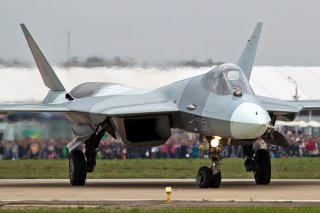Dream Match: China's J-20 Stealth Fighter vs. Russia's Su-57 (Who Wins?)
What would happen?
Overall, the Chinese J-20’s airframe shaping is far more conducive to stealth than the Su-57 air vehicle design.
Russia and China are both developing next-generation fifth-generation fighters as they struggle to challenge American dominance of the international system. However, the two great powers are taking somewhat differing approaches to developing these new next generation machines. Those differences are driven by a number of factors including threat perceptions and requirements as well as access to technology and financial resources.
(This first appeared several months ago.)
In terms of overall kinematic performance, the Su-57 is likely a superior performer compared to the Chinese J-20. With its three-dimensional thrust-vectoring capability and ample thrust, the Su-57 is likely to have excellent low speed high angle of attack maneuverability even with the current Saturn AL-41F1 afterburning turbofans, which are rated at 32,500lbs thrust each. The Russian jet should also have very good supersonic performance—with some degree of supersonic cruise capability even with the current AL-41F1 engines. However, once the Su-57 receives its second stage Saturn izdeliye 30 engines, which are expected to deliver roughly 28,000lbs of dry thrust and 42,000lbs of afterburning thrust, the PAK-FA should be able to achieve kinematic performance—including supersonic cruise and maneuverability—roughly on par with the Lockheed Martin F-22 Raptor. Indeed, as one now retired military official with extensive fifth-generation fighter experience had told me sometime ago: “Performance-wise it certainly looks to compete with the Raptor.”
Recommended: How an ‘Old’ F-15 Might Kill Russia’s New Stealth Fighter.
Recommended: How China Plans to Win a War Against the U.S. Navy.
Recommended: How the Air Force Would Destroy North Korea.
While the Su-57 has excellent aerodynamic design, the Russian jet is far less stealthy than the Chinese Chengdu J-20, let alone American stealth aircraft such as the F-22 or the Lockheed Martin F-35 Joint Strike Fighter. While neither the J-20 nor the Su-57 is particularly stealthy compared to American fifth-generation fighters, the Chinese aircraft places more emphasis of radar cross-section reduction measures than the Russian jet. The Su-57 has numerous obvious radar cross section hotspots including its rounded electro-optical sensor ball—which shows no effort at faceting—its moveable leading edge root extensions, where the leading edge flaps meet the outboard portion of the wing, its engine inlet design and a host of other problem areas. In short, the Russians consciously chose not to emphasize stealth in the Su-57 design.
By comparison, the J-20—which seems to have been heavily based on F-22 and F-35 technology—makes much more of an effort at especially frontal radar cross-section reduction. While some analysts make the spurious argument that canards are not compatible with stealth, there are plenty of American stealth aircraft concepts and technology demonstrators that have use such aerodynamic features including Northrop Grumman’s proposal for the Naval Advanced Tactical Fighter and Lockheed Martin own early Joint Advanced Strike Technology (JAST) —which eventually evolved into the F-35—development work. That being said, the J-20 does have some obvious radar cross-section hotspots, particularly toward the rear of the airframe.
Nonetheless, the Chinese have incorporated advanced stealth features such as faceting for the J-20’s electro-optical/infrared targeting sensor (EOTS) housing—liberally borrowing concepts from the F-35. Moreover, the J-20 also similarly works to conceal its electro-optical/infrared distributed aperture sensors (DAS)/missile warning system (MWS) in a similar manner to the F-22 and F-35 designs. The Chinese jet also incorporates F-35-style diverterless inlets, which somewhat compromise aerodynamic performance, but are more conducive to stealth and ease of manufacture and maintenance. Overall, the Chinese J-20’s airframe shaping is far more conducive to stealth than the Su-57 air vehicle design.
The Chinese aircraft likely falls well behind the Su-57 in terms of raw kinematic performance—both in terms of maneuverability and high-speed supersonic performance. The problem the Chinese face is that Beijing lacks a jet engine that can adequately power the J-20. Right now, the J-20 seems to be powered by the Russian-made Salyut AL-31FN engines, which provide roughly 32,500lbs of afterburning thrust each. However, some reports suggest that the Chinese are fitting early production J-20 aircraft with Chinese-developed thrust vectoring WS-10G copies of the AL-31FN. A more powerful and suitable indigenous 40,000lbs thrust class WS-15 is under development, but it is not clear when the Chinese will be able to consistently mass produce that engine. Theoretically, with the new engine, the J-20 should be able to cruise supersonically—but even then it will probably lack the Su-57 maneuverability.
In terms of sensors, it is unclear which aircraft is more advanced—it is clear however that the Russians and Chinese have completely different concepts of operation. The Su-57 was never designed as a genuine stealth aircraft and has a sensor suite designed to neutralize Western stealth aircraft. The Russians are hoping the Su-57’s sensor suite—which includes N036L-1-01 L-band radar arrays—will alert its pilots to the general vicinity of enemy fifth-generation stealth fighters such as the Raptor. Tactical fighter-sized stealth aircraft must be optimized to defeat higher-frequency bands such the C, X and Ku bands as a matter of physics. Those aircraft show up on radar operating at longer frequency wavelengths such the L-band, however, the track is not precise enough to engage a target with a missile.
However, the L-band radar—part of the N036 Byelka radar suite—narrows the search area down so that the Su-57 can scan a smaller volume of space with its X-band N036-1-01 and N036B-1-01 active electronically scanned array apertures. The radar is further augmented with the 101KS Atoll electro-optical targeting system and the L402 Himalayas electronic countermeasure suite, which would help further refine a track from the L-band radar. The idea is that a focused search by the Su-57’s other sensors would result in a weapons quality track to engage a fifth-generation fighter such as a F-22. It’s a good theory, but it is far from certain that it would work in practice.
The J-20, however, is probably not designed as a dedicated air superiority fighter like the Su-57 is. Its concept of operations seems to be based on American ideas about how to operate a fifth-generation fighter aircraft. Not much is known about the specifics of the J-20’s avionics and sensor suite, but the Chinese jet seems to incorporate an active electronically scanned array, a chin mounted EOTS, a passive infrared/electro-optical DAS 360-degree spherical camera system and passive antennas for an advanced electronic support measure suite similar to the F-35’s AN/ASQ-239 system. The J-20 also seems to incorporate advanced datalinks, integrated avionics and a cockpit with a display similar to that found on the F-35. Indeed, the J-20 likely has avionics that are broadly comparable to that found on the F-22 and F-35, but which are not quite as refined as their American counterparts.
The J-20 has a sensor suite similar to the F-35 because it is likely designed primarily as a long-range strike aircraft intended to threaten American bases and maritime assets in the Pacific. It would also likely have a role in disrupting American air operations during wartime by attacking U.S. aerial refueling tankers and airborne assets such as the E-3 AWACS, E-8 JSTARS or E2D Hawkeye and other similar support aircraft with long-range air-to-air missiles using its combination of speed and stealth. It is probably not designed to directly engage American fifth-generation fighters such as the F-22 or F-35 except in self-defense. By contrast, the Russian Su-57 is a dedicated air superiority machine that is designed to hunt down American fighters such as the F-22 and F-35—where it is successful or not is another question.
The bottom line is that the Russians and the Chinese had different requirements and design priorities that led them to make different tradeoffs when developing their respective fifth-generation fighters.
Dave Majumdar is the former defense editor of The National Interest.
Image: Creative Commons.


